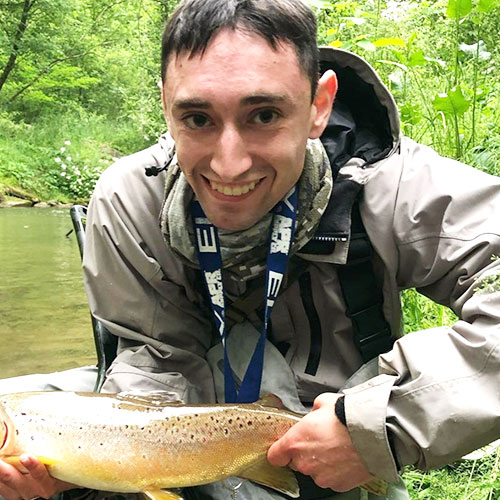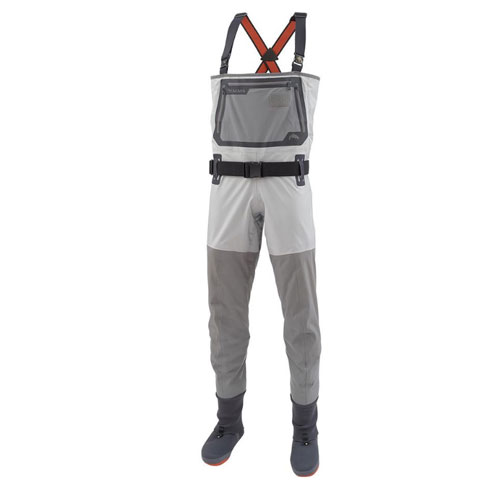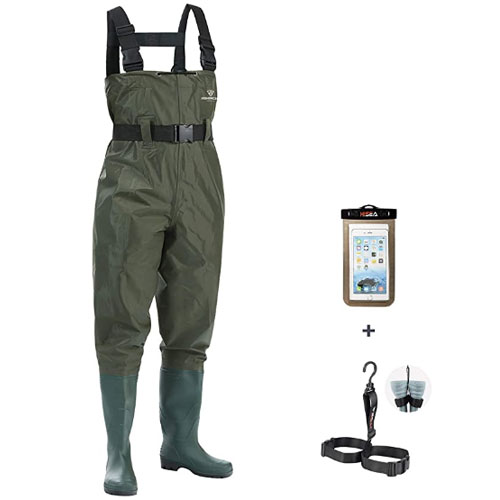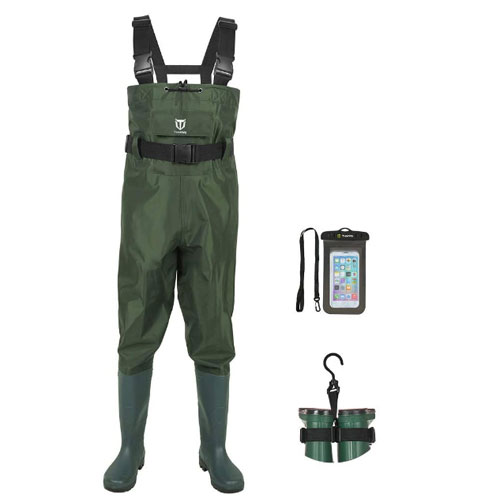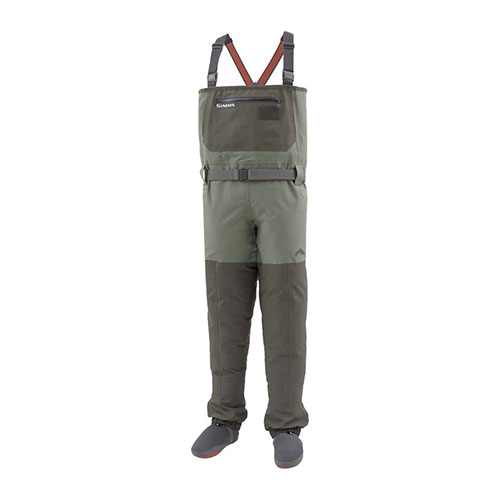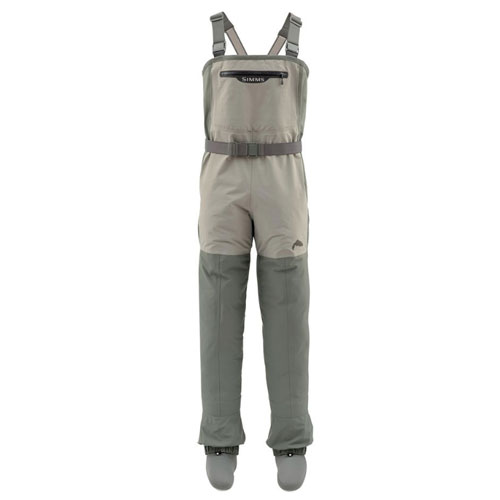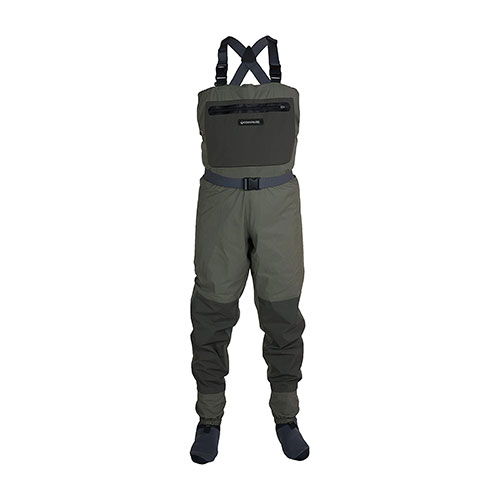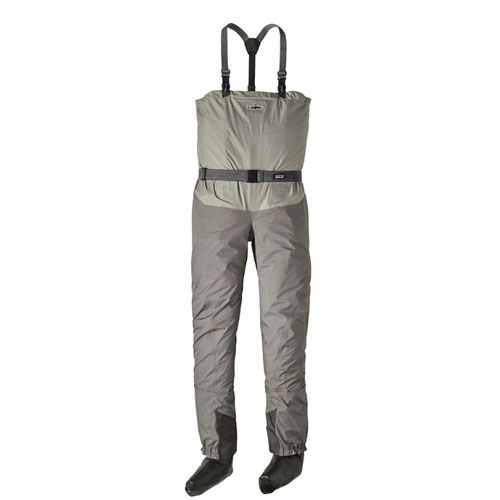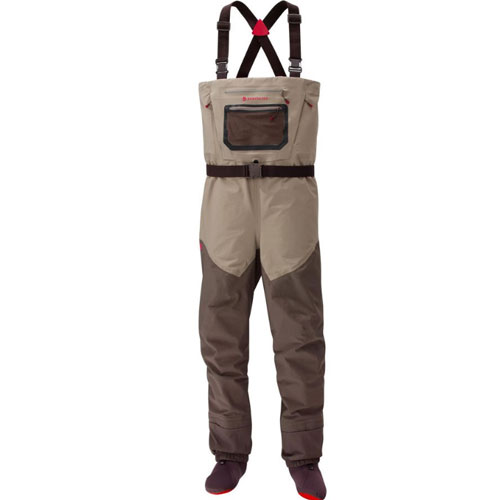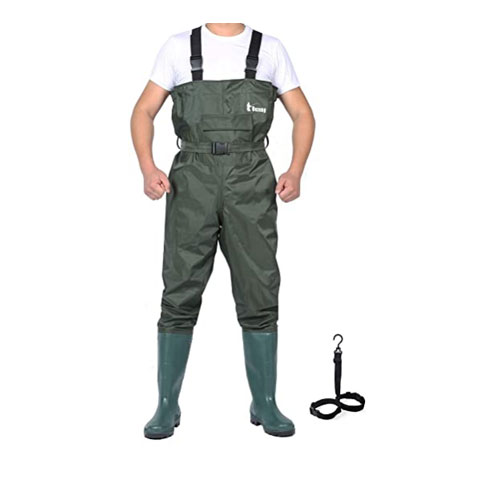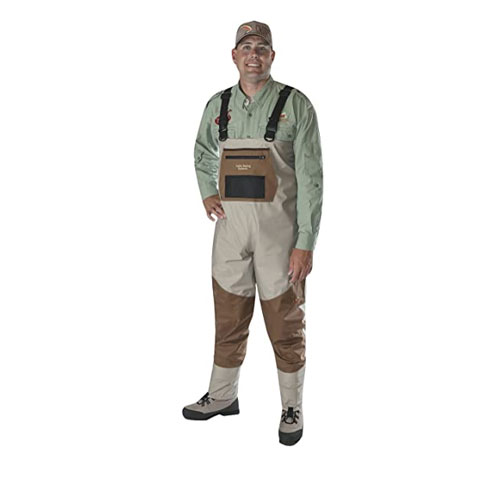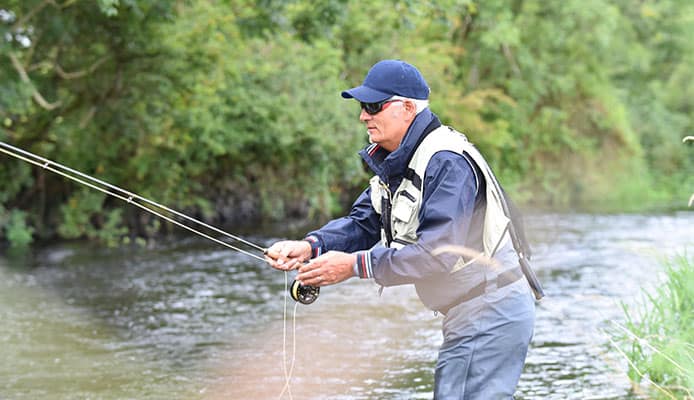
-
1.
-
2.
-
3.
-
4.
-
5.
Fly fishing is very dynamic and the exact placement of your fly can make a big difference in the outcome. Because of this, standing on the shore usually doesn’t cut it – you need to get closer to the action. Unless you want to be completely soaked from the waist down, you’ll need a pair of fly fishing waders before you step into the water.
By keeping your legs dry and protecting your feet, the best chest waders for fly fishing allow you to move around in the water and find your perfect fishing spot. Besides being waterproof, the waders you choose also need to be comfortable, functional, and fit perfectly. To help you choose, this article will take a look at the best fly fishing waders currently on the market, guaranteed to make every fishing session more enjoyable.
OUR TOP PICK
Simms G3 Guide Stockingfoot
- Stand Out Features - Why We Love It
- Multi-layer Gore-Tex Pro shell keeps your legs completely dry
- Gravel guards on the legs protect you from debris in the water
- Comfortable and adjustable suspenders improve the wader fit
- Fleece-lined hand warmer pocket for warming your fingers up
- Reinforced seams on the legs make the wading pants more durable
Best For: Frequent Fishing
Material(s): Gore-Tex Pro
Waterproof: Yes
Suspenders: Yes (Adjustable)
Belt: Yes
Weight: 2 pounds 13.8 ounces
Gender: Men’s
EDITORS CHOICE
FISHINGSIR Waterproof
- Stand Out Features - Why We Love It
- Equipped with tough rubber boots for walking on rough terrain
- Dual-layer nylon shell with PVC coating keeps water out
- Heat-welded seam design eliminates any chance of leaking
- H-Back suspender layout for increased comfort and adjustability
- Flip-out chest pocket keeps your valuables secure but close to hand
Best For: Water Protection
Material(s): Dual-Layer Nylon with PVC
Waterproof: Yes
Suspenders: Yes (Adjustable, H-Back)
Belt: Yes
Weight: 6.4 pounds
Gender: Men’s
BEST VALUE
TIDEWE Bootfoot Chest
- Stand Out Features - Why We Love It
- High-quality nylon construction with PVC reinforcement
- Precision stitching and heat-welded seams keep you dry
- Rugged rubber boots with additional toe protection
- Flip-out chest pocket for keeping your phone and keys
- Package includes a hanger that makes drying easier
Best For: Wearing Comfort
Material(s): 2-ply Nylon with PVC
Waterproof: Yes
Suspenders: Yes (Adjustable, H-Back)
Belt: Yes
Weight: 5.5 pounds
Gender: Unisex
- Stand Out Features - Why We Love It
- Neoprene booties keep your feet dry and prevent odor
- Waterproof zippered chest pocket for stashing your valuables
- Fly patch on the chest for keeping your flies close to hand
- Gravel guards prevent abrasion and improve durability
- Four-layer Toray fabric resists tears and keeps water out
Best For: Easy Movement
Material(s): Toray QuadraLam
Waterproof: Yes
Suspenders: Yes (Adjustable)
Belt: Yes
Weight: 2 pounds 6 ounces
Gender: Men’s
- What Makes This Fly Fishing Wader Stand Out
- Designed to fit female anglers perfectly
- Hand pocket with fleece lining to warm your hands
- Zippered pocket on the chest for tools and small items
- Articulated fit fr natural and unrestricted movement
- Four layers of Toray fabric guarantee dry legs in the water
Best For: Female Anglers
Material(s): Toray QuadraLam (4-layer)
Waterproof: Yes
Suspenders: Yes (Adjustable)
Belt: Yes
Weight: 1 pound 14 ounces
Gender: Women’s
Compass 360 Deadfall Breathable
- Stand Out Features - Why We Love It
- Double-taped 4mm neoprene booties with an ergonomic fit
- Taped seams improve durability and prevent any leaks
- Adjustable chest drawcord for fine-tuning the fit
- Reinforced knee pads and shins resist tears and abrasion
- Flip-out security pocket is perfect for keys and phone
Best For: Cold Weather
Material(s): Polyester with DWR
Waterproof: Yes
Suspenders: Yes (Adjustable)
Belt: Yes
Weight: 1 pound
Gender: Unisex
- Stand Out Features - Why We Love It
- Packs down very small to make carrying more convenient
- Gusseted crotch design gives you free leg movement
- DWR coating on the shell improves water protection
- Seamless booties guarantee top-level foot comfort
- Ultralight convertible wader with great versatility
Best For: Packing and Transportation
Material(s): Nylon and Polyester with DWR
Waterproof: Yes
Suspenders: Yes (Adjustable)
Belt: Yes
Weight: 1 pound 10 ounces
Gender: Men’s
- Stand Out Features - Why We Love It
- Four-layer nylon fabric prevents water from getting in
- Easily-adjustable waist and suspenders provide a great fit
- Fleece-lined hand warmer pocket for keeping your fingers warm
- SonicWeld seams improve durability and minimize bulk
- ActiveFit design improves your comfort while fishing
Best For: Fit Adjustability
Material(s): 4-Layer Nylon
Waterproof: Yes
Suspenders: Yes (Adjustable)
Belt: Yes
Gender: Men’s
Ouzong Bootfoot Lightweight
- Stand Out Features - Why We Love It
- High-quality 70D nylon shell works great in harsh conditions
- Flip-out chest pocket keeps your valuables dry and protected
- H-back suspenders with quick-release buckles for easier use
- Significantly lighter than traditional models made from rubber
- PVC boots with thick soles for safely walking in water
Best For: Leg Protection
Material(s): 2-ply 70D Nylon with PVC
Waterproof: Yes
Suspenders: Yes (Adjustable, H-Back)
Belt: Yes
Weight: 5.5 pounds
Gender: Unisex
Caddis Tauped Deluxe
- Stand Out Features - Why We Love It
- Two-color design looks really nice in and around water
- Premium breathable shell allows sweat to escape so you stay dry
- Equipped with gravel guards to improve leg durability
- Double taped seams (inside and out) for additional protection
- Reinforced knee pads allow you to kneel without tearing the fabric
Best For: Breathability
Material(s): Polyester
Waterproof: Yes
Suspenders: Yes (Adjustable)
Belt: Yes
Weight: 2 pounds
Gender: Men’s
How To Choose The Best Fly Fishing Wader – Buying Guide
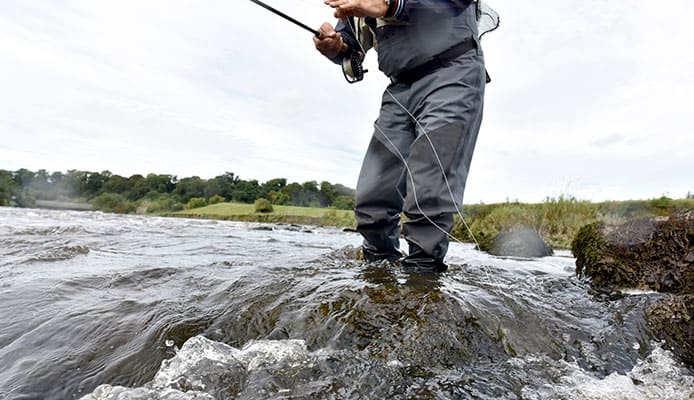
Material
The material is probably the most important feature to consider when choosing the best fly fishing waders. It’s difficult to say outright which material is best because it depends on your fishing location and weather conditions.
Breathable Waders – If you fly fish in warm weather, you need premium breathable waders. The fabric of choice here is usually polyester that provides impressive water protection while allowing moisture to escape so the fly fisher get sweaty.
Nylon/PVC – Nylon/PVC waders are made from heavy-duty nylon fabric with a PVC coating to effectively keep water out. They are lighter and more comfortable than neoprene but don’t perform as well in cold conditions.
Neoprene – Ideal material if you’ll be fishing in the winter. While neoprene waders aren’t particularly flexible, they are the best fly fishing waders when it comes to keeping your legs warm.
Weight
The best fly fishing waders need to be lightweight – this makes it easier to walk in water, get them on and off, and pack them when it’s time to go. Unlike breathable waders, heavy models weigh you down and make it significantly harder to move in the water.
Foot Design
In terms of foot design, there are two types of fly fishing waders – bootfoot and stockingfoot. The best design will depend on your fishing style, terrain, and your personal preference.
Bootfoot Waders – Bootfoot waders have a pair of waterproof rubber or PVC wading boots built into the foot part of the waders. Their simple and affordable design makes them great for beginner anglers, short distances, and gentle streams.
Stockingfoot Waders – Avid fly fishers prefer the more expensive but more versatile stockingfoot fly waders. These have neoprene stockings or socks welded into the foot part of the wader. Even though you need to purchase a pair of wading boots separately, they’re the best fly fishing wader design for frequent use, deep water and difficult terrain.
Size and Fit
The proper fit in waders is neither too tight nor too loose. It should be only slightly loose but without extra materials. This relaxed fit will allow freedom of movement, allow you to sit or kneel without stressing the seams, and offer room for insulating layers when necessary.
Height
Based on the depth of the water you’ll be wading in, fly fishing waders are sorted into three categories – hip, waist, and chest waders.
Hip Waders – This type extends from your feet to your hip where it attaches to your belt. They keep you dry from your legs to your hips and are a good style to wear when leisure fishing in shallow, slow-moving waters.
Waist-High Waders – As their name suggests, they extend from your foot to your waist, just like a pair of pants. These waders for fly fisherman the safest to wear as there is no risk of them filling up with water in case of an accidental dunk into the water.
Chest Waders – The top of these waders reaches up to your chest. The design is similar to overalls and has over-the-shoulder buckle fastenings. This is the most common wader height and all the best fly fishing waders reviewed above are chest high.
You might also like: Fishing Shirts
Quality
Fishing waders aren’t something you buy every day, so it’s better to invest in a pair that will last for a long time. If you’re willing to spend a bit more, you can never go wrong with reputable wader brands such as Orvis breathable waders, Hodgman fishing waders, or waders by Patagonia, Cabelas, and Simms among others.
Additional Features
In addition to water protection, the best fly fishing waders often have some additional features that improve their durability, enhance wading safety, or offer convenience while in the water. Some of these features include:
Reinforced Knees And Seat – Extra layers of fabric and additional cushioning improve durability in these high-wear areas.
Integrated Gravel Guards – Built-in gravel cuffs cover the top of wading boots to prevent small debris such as sand and gravel from getting in.
Pockets – Most fly fishing waders feature conveniently placed chest pockets, while some even have an inside flip-out pocket for keeping your phone and valuables dry.
Waist Belt – All the best chest waders for fly fishing come with a waist belt that makes them more secure and prevents the pants from getting flooded if you slip.
Color – The choice of color is mostly a matter of personal preference, but some anglers claim that your waders should blend into the environment so they don’t spook the fish.
FAQs
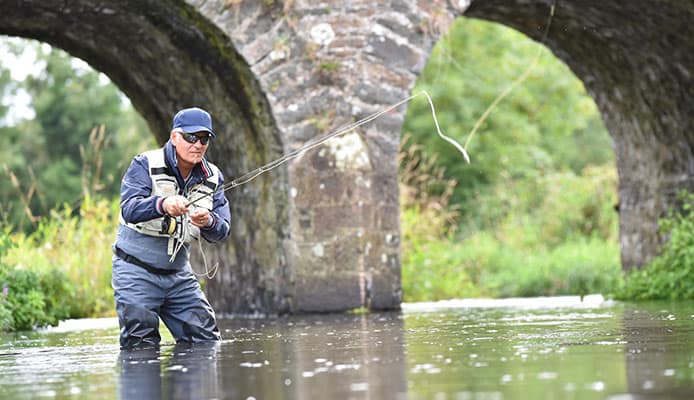
Q: What Are The Advantages of a Fly Fishing Wader?
A fly fishing wader gives you the flexibility of stepping into the water and getting closer to where the fish are. It allows you to position yourself and cast the fly better so you can maximize your chances of making a catch. In addition to physically protecting your legs and keeping them dry, waders also provide additional warmth in cold weather.
Q: Do I Need Fly Fishing Waders?
Yes, if you plan to get into the water. Not only do the pant waders keep your legs dry and warm in cold water, but they also provide additional protection from the objects and creatures in the water.
Q: How To Clean My Fishing Waders?
After every wading excursion, make sure to rinse your waders thoroughly with fresh water to remove any residues or saltwater and then leave them to completely dry (both inside and outside). In addition to this, you should give your waders for saltwater fishing a thorough cleaning every two or three trips – hand wash them with a mild detergent or a specialty cleaner for waterproof materials. Make sure to follow the manufacturer’s instructions and never to use bleach.
Q: What Should I Look For In Fly Fishing Waders?
The most important things to look for when choosing the best chest waders for fly fishing are the fit and material quality. In other words, the waders should be comfortable to wear and keep your legs dry and protected when you’re in the water.
Globo Surf Overview
Fishing waders are a great addition to your gear that allows you to thread in the water and cast your flies more effectively. We hope that our guide and reviews helped you choose the best fly fishing waders for your fishing style so you make your fly fishing experience even better.
More Fishing Apparel Reviews:
- Fishing Pants
- Fishing Shorts
- Fishing Boots
- Waders For Women
- Hip Waders
- Boonie Hats
- Fishing Gloves
- Fishing Vests
- Fishing Jackets
Do you own any of the above fly fishing waders? How’s their performance on the water? We would love to hear your experience. Share with us in the comment box below.


